Calculating the parameters of a heating system with natural circulation: how to achieve uninterrupted operation?
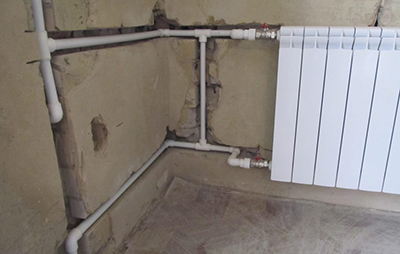
A heating system with natural circulation of liquid is a closed device of the gravitational (gravity) type, allowing heat the premises in a private house regardless of the power supply.
This design advantage makes it possible to use it in regions with problems or complete absence of a central electrical network. The system economical, but for its proper functioning it will be necessary to make precise calculations.
Content
Description of the heating system of the circulation type without a pump
Device water heating, working by gravity, turns on the heating element (boiler), pipes, laid in different ways, expansion tank and radiators.
Operating principle
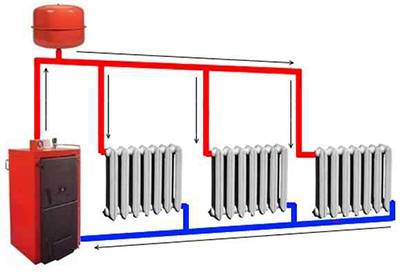
The role of the coolant in the circuit is played by water, which moves through the pipes under the influence of thermodynamic forces. The principle of operation of the system is based on on the difference in physical properties of hot and cold water.
While the boiler is operating, there is always hot water in the pipes, which gradually cools down, passing through the circuit and giving off heat to the environment.
The density and mass of water decreases when heated, so it easily is forced upward by the cooled liquid.
After reaching the top of the circuit, hot water is distributed through pipes connected to radiators, gives off heat through the material of the batteries, and then flows down the lower part of the circuit to the boiler, where it is heated again.
Advantages of installation
The main ones advantages The heating circuit of the gravity type are:
- easy to install and use;
- high heat output and microclimate stability premises;
- resource efficiency provided that the building is well insulated;
- absence of noise;
- complete independence from electricity;
- rare breakdowns and long service life subject to periodic preventive measures.
Reference! It is possible to design a heating system with natural circulation on one's own. Correct calculation of parameters, selection of circuit diagram and competent installation of all components guarantees the service life of the structure up to 35 years old.
The main disadvantage is that the design can only heat private houses area no more than 100 m2, having a radius about 30 m.
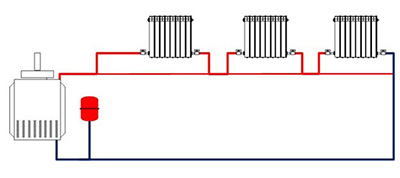
There are several more disadvantages, limiting the use of gravity-flow design:
- mandatory presence of an attic for installation of expansion tank;
- slow heating premises;
- the need to insulate the circuit in unheated areas to prevent water from freezing in pipes.
Types of heating systems with natural circulation
The designs can be implemented in single-pipe or double-pipe versions. By type of system, closed and open installation schemes are distinguished. The correctly selected type of scheme will ensure its maximum efficiency.
Closed type
The closed-type circulation design has become widespread in European countries, and only in Russia is starting to gain popularity.
Schematic diagram
After heating, the water rises under pressure to the expansion tank, divided into 2 parts by a membrane. The lower part of the tank is filled with water, which compresses the gas (usually nitrogen or air) located in the upper part above the membrane. Additional working pressure is created, facilitating the movement of the liquid.
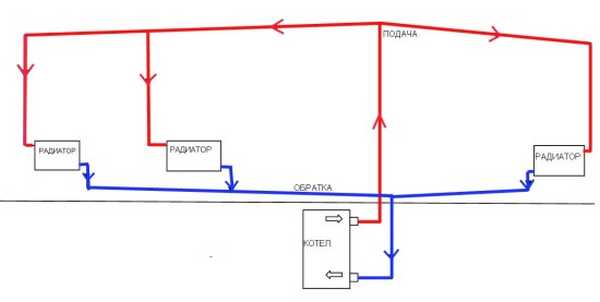
Photo 1. Closed type heating system with natural circulation. Must be equipped with a sealed expansion tank.
Peculiarities
The main feature of the closed type design is the tightness of the tank and the creation of additional pressure in the pipeline. Sometimes for closed circuits they use Circulation pumps, which operate from the mains. Due to the low power consumption of the pump, a temporary power outage will not affect the operation of the system.
Pros and cons
The main advantages of closed heating systems are related to their tightness. Due to this, the system almost does not suffer from air locks, is less susceptible to corrosion, and consumes less coolant, which can be not only water, but also antifreeze. Scheme does not require large pipeline slopes, especially if a pump is used.
Attention! The main disadvantage of the design is the need to install a large tank, which requires space. Long power outages will lead to to a decrease in the efficiency of the pump circuit.
Open type
An open-type heating system includes an open, non-hermetic expansion tank. This design is often used in older buildings. Although it is losing popularity, the open scheme remains reliable and efficient.
Scheme of work
The heating system with natural circulation of the open type differs from the closed type only in the design of the tank and no need to install an electrically dependent unit.
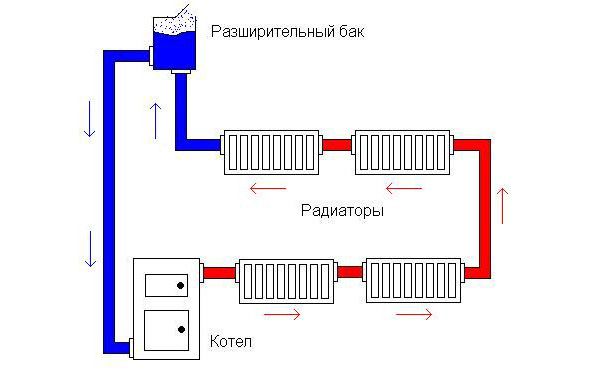
Photo 2. Open type circulation heating system, equipped with a non-hermetic expansion tank, without an electric pump.
Design difference
Tank for open device can be made from scrap materials and small in size. The container does not necessarily have to be located at the highest point.
Positive and negative sides
The advantages of the design include ease of installation, safety and independence from external power sources. Negative aspects of open-type systems associated with air entering the circuit, which is the cause of the formation of plugs, evaporation of water and the need to control its quantity, as well as the impossibility of using antifreeze due to its harmful effects.
Single pipe
The single pipe design uses only one pipeline line. It has low efficiency, so it is used for heating small rooms.
Circuit
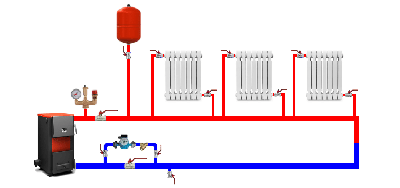
The pipes from the heating boiler run along the entire perimeter of the room, connecting sequentially to the registers.
Hot water enters the radiator through the upper connection, and drains through the lower one. From the last register The cooled liquid flows back to the boiler by gravity.
Description of the design
For the system to function well, the contour is installed under the ceiling, and the pipes carrying the cooled liquid to the boiler are under the floor surface. When choosing a single-pipe system, the boiler with batteries can be placed at the same level. The expansion tank is installed at the highest point of the circuit.
Advantages and disadvantages
The undoubted advantage of the design is the ease of its installation and cost-effectiveness due to the minimum number of pipes. The disadvantages of a single-pipe circuit include: heat loss from register to register. It is not recommended to use such a system for heating two-story buildings.
Double pipe

To create a two-pipe system, a pipeline is laid for the direct supply and return flow of liquid.
Planning and the installation of the structure is quite complicated, but provide efficient heating.
Operating principle
The outline must be carefully thought out and designed as follows:
- The main riser coming from the boiler is connected to the expansion tank at a distance of approximately 1/3 from the total height of the contour.
- After the tank, the main pipe is connected to the distribution of pipes through which the hot coolant is supplied.
- To remove excess liquid, the tank is equipped with an overflow pipe., connecting it to the sewer system.
- The pipes through which the cooled water will move to the boiler, are installed in the lower part of the registers parallel to the pipes containing the hot coolant.
Structural features
The main riser, as well as the room in which the tank is located, are insulated, which will prevent heat loss and freezing of the system. The heating boiler is located lowest in the recess or in the basement.
Advantages and Disadvantages
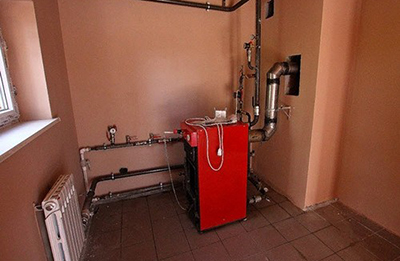
The main advantages of a two-pipe gravity heating system are uniform heat distribution between the circuit nodes, ease of adjustment, the possibility of using pipes of smaller diameter.
The design allows for correction of calculation and installation errors without reducing thermal efficiency.
The system has virtually no disadvantages, with the exception of long-term preparatory activities. But it is worth the time and effort to create a well-functioning heating circuit.
Creating a suitable slope for gravity flow
The main requirements and standards applied to the creation of heating systems are presented in SNiP 41-01-2003.
To reduce the factors that counteract the normal flow of the coolant in the pipes (circuit bends, air locks), follow the recommendations for the slope of the system pipes. Slopes are made along the flow of liquid based on the calculation from 1 to 5% depending on the length of the pipeline. Thanks to the correct slope, the air accumulated in the pipes will pass to the expansion tank, where it will be released.
Important! Regardless of the slope of the pipes, air bleed valves are installed in an open-type gravity heating system. For two-pipe structures installation is in progress taking into account the slope of both parts of the contour.
Calculation of the diameter of the circuit pipes
For gravity-flow structures, it is necessary to use pipes of a larger diameter than for systems with forced circulation.
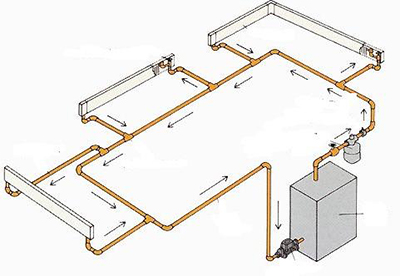
The following will help you to correctly calculate the diameter: rules:
- After calculating the thermal energy required to heat the room, the result obtained is increased by 20%.
- According to the formulas given in SNiP using an online calculator calculate the cross-section of pipes.
- The material of the future pipeline is taken into account: Steel pipes must be at least 50 mm in diameter. It is recommended to connect this type of pipe to the boiler as a riser.
- After each branching of the circuit reduce the diameter of the pipes by 1 size, for reverse current, on the contrary, they increase.
Correct calculation of the diameter of the pipes used, as well as their slope, allows you to create a heating system that functions without any problems.
Useful video
The video provides an overview of the heating system, which can operate with both natural circulation and a pump.
Brief conclusions
Heating rooms in the cold season with unstable power supply is a solved problem. Heating systems with natural circulation of the coolant create comfortable conditions in private houses without the use of electricity. The designs are economical, efficient and safe if the circuits are planned and installed correctly.







Comments